Summary: The market is brutal, and the competition isn’t getting any easier. How can any company stand out and win over people’s hearts? Testimonials allow you to highlight your clients’ positive stories and achievements while receiving good publicity. Let’s see how you can encourage more testimonials from your customer base.
Why Are Customer Testimonials Important?
You can’t expect customers to take your word for it when it comes to product value. Testimonials are social proof that helps prospects understand the usefulness and features of your product through past success stories. It’s an entirely psychological concept that influences people to take some actions and form certain opinions. When someone sees triumphant customer testimonial examples, they are easily swayed toward purchasing your solution. Usually, businesses try to get testimonials from their most recognizable clients to establish credibility and appeal to enterprises and generate high-quality business leads. Also, client testimonials showcase your value, customer-centric approach, and product capabilities.
eLearning tools like 360Learning, TalentLMS, Docebo, Absorb, and Adobe Learning Manager are highly regarded in terms of social proof, trust, and credibility. Whether it’s gathering reviews from real users or asking an eLearning authority to provide a testimonial, vendors have a lot to gain. Besides, the more positive reviews you receive, the higher the chances of receiving eLearning Industry’s People’s Choice LMS award.
Are you struggling to reach targeted eLearning and HR customers?
Check out our Media Kit and understand how it can help you with targeted lead generation!
In This Guide, You Will Find…
- What Do Successful Testimonial Examples Have In Common?
- 8 Types Of Customer Testimonials You Can Use
- Successful Customer Testimonial Examples
- Where Should You Place Testimonials For Maximum Impact?
- How Can You Collect More Testimonials From Your Customers?
- Great Practices For Showcasing Your Testimonials
- Statistics Highlighting How Testimonials Build Trust
Statistics Highlighting How Testimonials Build Trust
- The Edelman Trust Barometer found that 64% of millennial consumers and 60% of Gen Z consumers will try out a company’s product if they can trust the brand.
- The same report found that 67% of buyers will stay loyal to a brand if they can fully trust it.
- 92.4% of B2B customers read reviews online. When companies receive over 10 reviews, they increase their search traffic by 15–20%.
- Video testimonials are so powerful that they can increase website traffic by 157%.
- Placing your customer testimonials on product pages can increase your annual revenue by 62%.
What Do Successful Testimonial Examples Have In Common?
-
Highlight Features
Some customer testimonial examples are the opposite of generic, as you want them to highlight specific features or product benefits. You can prompt clients to talk about these features by asking them directly about them. Or you can simply categorize testimonials based on tools.
-
Align Them To Your Goals
Your testimonials should speak to your ideal buyers’ hearts. For example, if you want to attract targeted leads in the eLearning field, focus on testimonials from relevant businesses and talk about your LMS and its ability to keep learners engaged.
-
Stick To Your Branding
The testimonial format should always align with your branding. Keep the same color palette and typography when you design quote blocks, testimonial cards, and images. Everything should look professional and on-brand.
-
Use Images And Videos
If visuals are important for your testimonials, ask customers to take their own high-resolution images and videos. If they are not willing to do that, don’t fall into the trap of staging visuals, as it can backfire. Avoid buying “plastic” stock images, too.
-
Be Specific
Another common characteristic of customer testimonial examples is specific details and feature benefits. You can ask clients to disclose exactly how your product helped them overcome their struggles and which feature was particularly valuable.
8 Types Of Customer Testimonials You Can Use
1. Quote
One of the most commonly used customer testimonial examples is quotes. They are quite easy to acquire, as customers don’t need to spend hours answering surveys and writing long-form reviews. They simply discuss their experience working with your brand in a few sentences. Not to mention, these testimonial examples are easy to include in various landing pages throughout your website for building trust. They are often followed by CTAs, prompting users to take action. It’s important you add the person’s credentials underneath the testimonial to prove its validity—people with high authority make your testimonial look more credible than an anonymous source.
2. Social Media
Almost all companies use social media for their online marketing strategies. B2B clients will most likely visit your profiles to check your activity, which is why it’s important that your social proof is evident there. How? Ask satisfied customers to give you a shoutout on social media by tagging you. On Facebook, they can leave a review directly on your page. You may gather these reviews and embed them in your website so visitors can easily view them. It doesn’t mean that they won’t visit other sources for more client testimonials, but they will get an initial taste of your brand’s positive image.
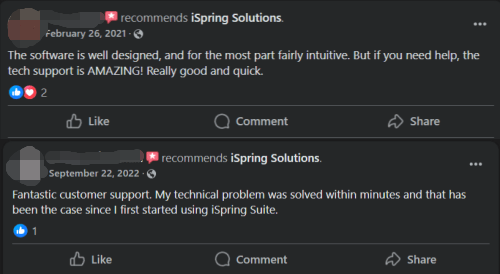
3. Reviews And Ratings
Apart from reviews on your website, you can encourage clients to visit other websites to leave their testimonials. For example, Google, Capterra, and Trustpilot are often visited by prospects during the consideration and conversion stages to identify the best vendor. In these places, customers usually go into a bit more detail regarding your collaboration. For example, they may mention specific product features that worked wonders for them, elaborate on your exquisite customer service, and explain how your pricing works. These customer testimonial examples are usually unbiased because users visit these websites without you necessarily asking them to.
What you should do is strengthen your online reputation management approach and visit these places regularly to answer people’s comments, whether positive or negative.
4. Case Studies
Case studies are the more in-depth customer testimonial examples that allow prospects to see exactly how you acted during a challenge and which pain points you eased. They usually start with the background of a company and the challenges it faced before purchasing your solution. Then, you talk about your course of action and the problems you encountered along the way. You explain in detail how you addressed issues and how your product features saved the day. In the end, you must provide data showing the improvements. This is a great example of a case study in the eLearning field.
If you want to promote a case study, eLearning Industry can help you do that through our weekly newsletters and social media posts.
Take a look at one more case study article to see how you should format your own testimonial.
5. Video
Video is one of the smartest lead gen tactics in all industries, including eLearning and HR. User testimonials come alive, and new prospects can see past clients speaking in front of the camera, detailing their positive experience with your brand. Yes, videos are time-consuming and challenging if you don’t have the right equipment, but they are worth the hassle. Through powerful storytelling, you can present a gloomy case and build it up until it becomes a success story. Throughout the video, you can show data and statistics to prove how your product improved a situation.
6. Interview
Interview clients’ testimonials can either be in written or video format. You can even create a podcast series diving deep into individual customer cases. These customer stories take longer to highlight, just like with case studies. You should prepare a series of well-thought-out questions and ask your customers to elaborate as much as possible. They should provide detailed answers that showcase the high value of your product and the challenges it helped them overcome. It’s best to ask up to ten questions. You can request the answers in written or spoken format, depending on your clients’ preferences. If they want to record their answers, you may then transcribe them.
7. Influencer
You may possess many product marketing manager skills. However, if you can’t get in touch with influencers and get their endorsement, you may lack one crucial characteristic. Customer testimonial examples include influencers’ opinions and reviews. You should find niche-specific thought leaders who are willing to try out your product and offer their genuine opinion. Their credibility and high status are the social proof you need to build your brand up. Also, these influencers can encourage people to make purchases quickly if they want to leverage a specific discount code or offer.

If you want to read more lengthy influencer reviews like this one, take a look at Adobe Learning Manager Reviews and iSpring Learn Reviews.
8. Blog Post
Short quotes may be easy to get and feature all over your website and social media. However, rich and lengthy client testimonials may be worth turning into full-fledged articles. These blog posts don’t have to be as detailed and long as case studies, but they can offer more information than reviews. You may gather a few of the most exciting testimonials and include them in a relevant article. Or you can create an article based on a single testimonial by giving out details regarding your collaboration. These articles can be promotional opportunities for longer case studies that are often used as gated content.
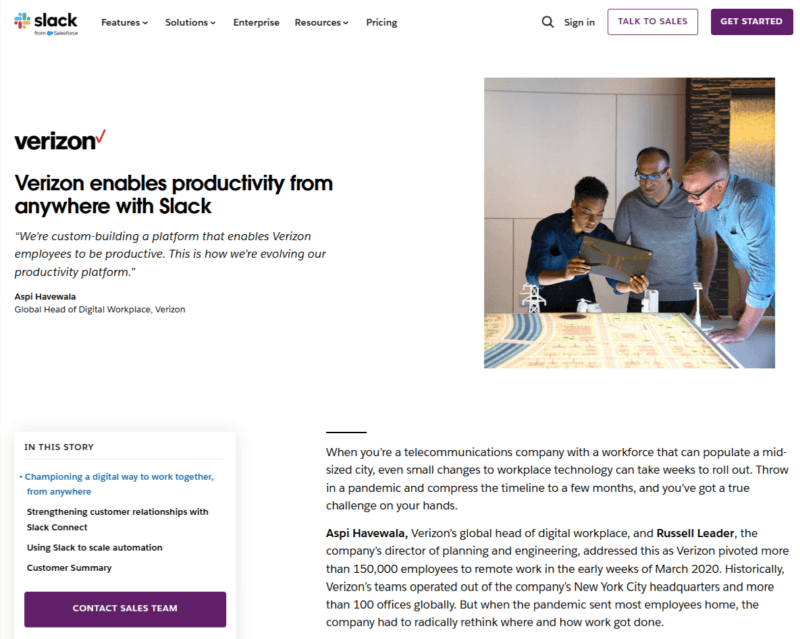
Successful Customer Testimonial Examples
-
SaaS
Zendesk is a customer service platform that helps businesses streamline customer communication. It has a dedicated testimonial landing page that features over 400 testimonials and customer stories. Its layout is simple, clean-looking, and organized. You can also filter testimonials based on industry, business pain point, region, and company size.
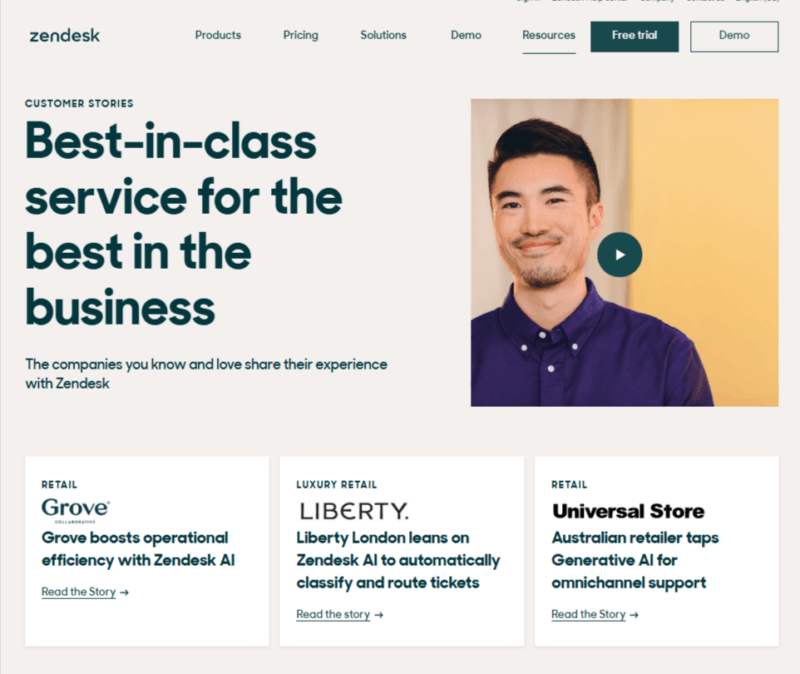
Another bright SaaS customer testimonial example is that of Canva. The platform is one of the most user-friendly for image and video editing. On its testimonial page, it features a high-profile customer’s story at the top. If you scroll down, you will see how many Forbes 500 companies use Canva on a daily basis.
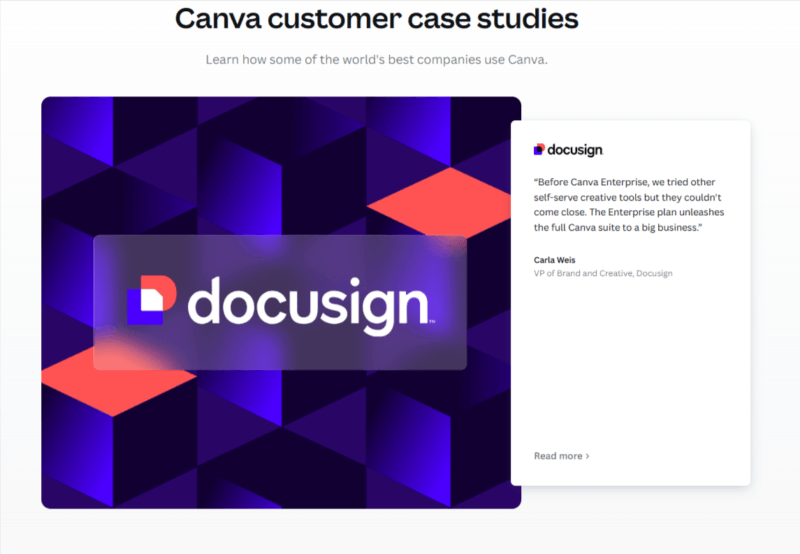
-
LMS Vendors
If you are looking for successful customer testimonial examples for LMS vendors, we have two wonderful pages for you. As you can see on TalentLMS’s page, they start by mentioning the number of teams leveraging the tool for training. Underneath, you can see the big names that have chosen this LMS and the awards and badges they have won. One of them is an eLI Top List Award. If you, too, want to win such an award, you can easily submit your candidacy.

On iSpring Learn’s product training LMS use case page, we can once again see the big names that have collaborated with the company. Under that section, the company highlights the benefits of their LMS and what you can do if you choose to purchase a subscription. It’s easy to see what the tool offers and how it can benefit companies of all sizes.
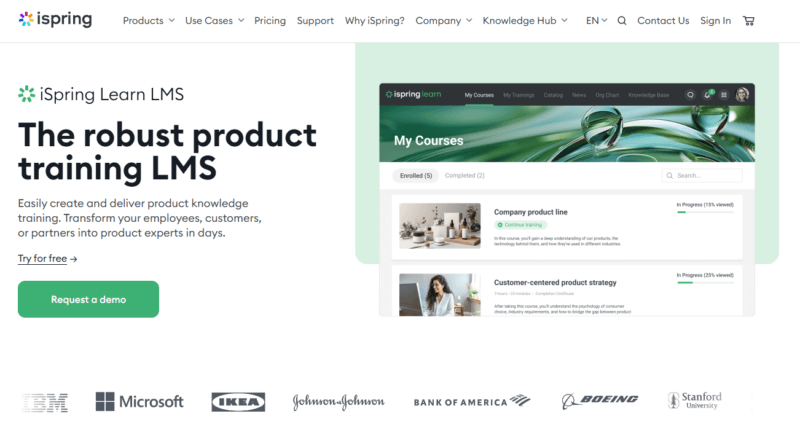
-
eLearning Companies
The competition for eLearning course providers is massive, and the only way to stand out is through triumphant client reviews. Let’s take Kashida as an example. The company has created a dedicated case study landing page that categorizes its work in four sections: learning delivery, learning design, learning production, and learning strategy. Under each section, you can find detailed case studies that explain the unique challenges of each customer and how it was tackled.
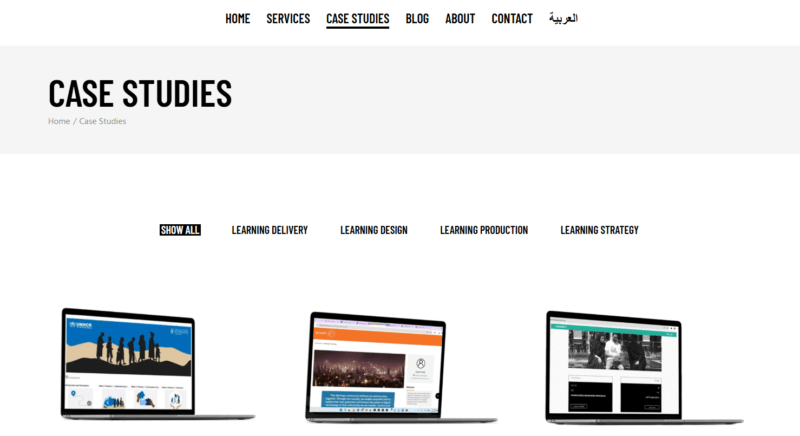
Mind Spring does it a bit differently. Its Portfolio starts with video highlights and then features case studies in different categories. It doesn’t focus on the companies but on the issue at hand and the goal. Once again, simplicity is the navigator, proving that these dedicated landing pages don’t have to be exaggerated to look legitimate.
-
HR Software
Qooper offers one of the most unique and inclusive customer testimonial examples. Its use case landing page doesn’t only feature quotes and case studies. Those come further down the page. At first, you can see the benefits of the company’s learning and mentorship programs, how they work, and the fact that they are ideal for large enterprises. This is particularly important to show that they are able to scale their programs according to demand.
UserGuiding is predominantly an onboarding software that also provides customer feedback, self-service help, and product announcement features. Its use case page is very simple. You basically choose the product feature you prefer and then browse detailed case studies.
Take a look at how reviews and ratings show on eLearning Industry’s HR directories. Apart from pros and cons, users can rate various aspects of your HR tool. You can choose exactly how many things you want them to rate.
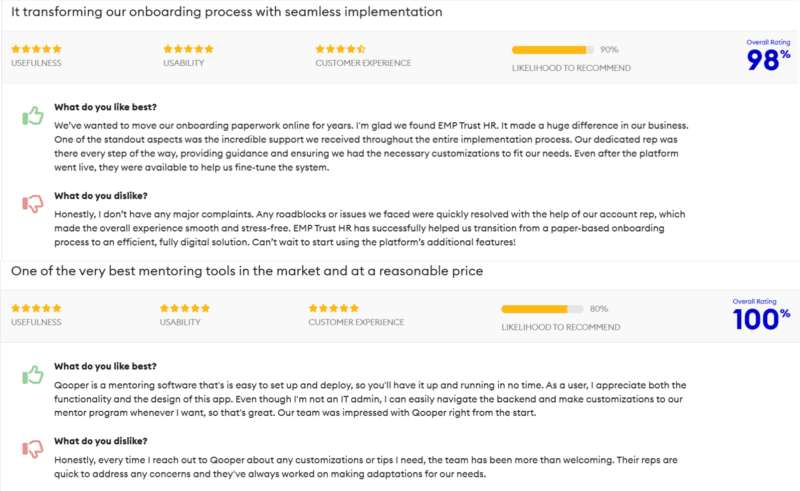
Where Should You Place Testimonials For Maximum Impact?
- Create a homepage “hero” section.
- Add them on pricing or sales pages.
- Include them on landing pages.
- Feature them in your emails.
- Add them to your paid ads and social proof ads.
- Incorporate them into slide decks and sales proposals.
But that’s not all. Directory submission sites are also a place where you can submit your business and its reviews. Choosing an upgraded listing allows you to not only add reviews and ratings, but also a CTA button that sends users straight to your website.
How Can You Collect More Testimonials From Your Customers?
-
Customer Feedback Surveys
One of the top applications of Artificial Intelligence in marketing is automating your feedback requests. Set email sends a few days after a customer purchases products. Ask them to rate you and leave their comments on specific pages.
-
Net Promoter Score (NPS) Surveys
NPS surveys usually include the question, “How likely are you to suggest us to someone else?” When someone answers “very likely,” you should save their contact details and message them when you are in need of fresh testimonials.
-
Customer Satisfaction Surveys (CSAT)
These surveys are also crucial for identifying who loved and who hated your product. In the former situation, you know whom you can contact for testimonial samples. In the latter, you know which clients might abandon you. This way, you can contact them to offer assistance and do some damage control.
-
Ask Your Loyal Customers
To get indexed on AI search engines, you need amazing reviews and testimonials. There is nobody better to give those to you than loyal, high-paying customers. Dig into your database to discover them and request an interview.
Great Practices For Showcasing Your Testimonials
- Add customers’ real names, photos, and job descriptions.
- Use outstanding headlines and quotes derived from the testimonial.
- Keep the description brief and result-oriented.
- Pair them with actionable CTAs, like “Try it yourself.”
Do you want to show off customer testimonials at a prominent location?
Create a PPC directory campaign and put your bright yellow stars ahead of the competition.
Key Takeaway
Customer lifetime value is based on many things. One of them is a genuine interest in what your customers have to say about your brand. As you can see in other successful customer testimonial examples, companies place a massive focus on collecting celebratory and overall positive reviews from clients. A mix of quotes, social media posts, videos, case studies, blog posts, ratings, interviews, and influencer testimonials can improve your company’s brand image significantly. You may prepare the best elevator pitch. However, it won’t play well if you have nothing to show for it. B2B customers want to see past results before they choose to buy your software or product.
So, keep sending feedback requests and incentivize customers who are not easy to convince to give reviews. Whether you are in the eLearning, HR, marketing, or consulting world, testimonials can take you to that next level of advocacy and loyalty.
Customer testimonials are endorsements from satisfied clients. They are detailed reviews of your product’s benefits, and they come in various forms: written, video, influencer, quote, case studies, social media posts, etc.
They increase your brand’s credibility and convince other prospects to buy your solution more easily. They also make you look like a trusted figure in your niche.
- Ask for reviews after every purchase.
- Create a customer loyalty program to incentivize clients.
- Send out personalized requests.
- Respond to online feedback.
- On your landing pages and product pages.
- On social media platforms.
- In your email marketing campaigns.
- On printed materials (if you use them), including brochures.

Teamo
Transform your workplace into a hub of motivation and appreciation. Teamo’s all-in-one platform celebrates achievements, fosters collaboration, and ensures every team member feels valued.






